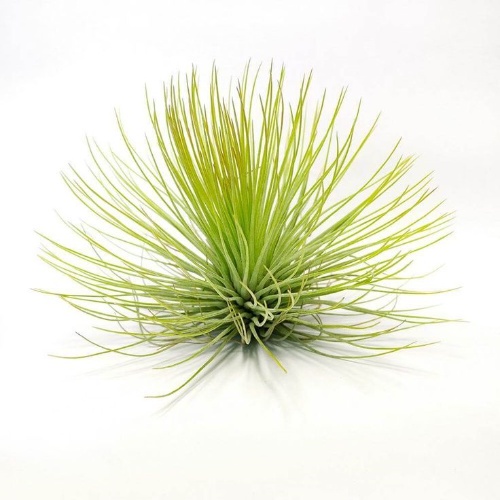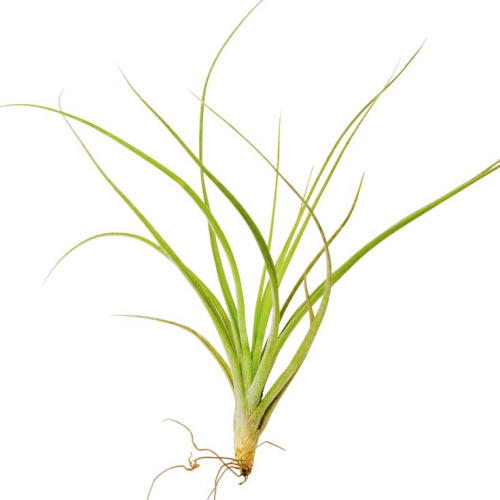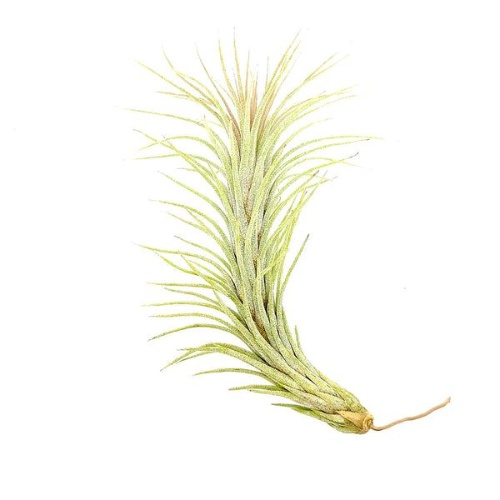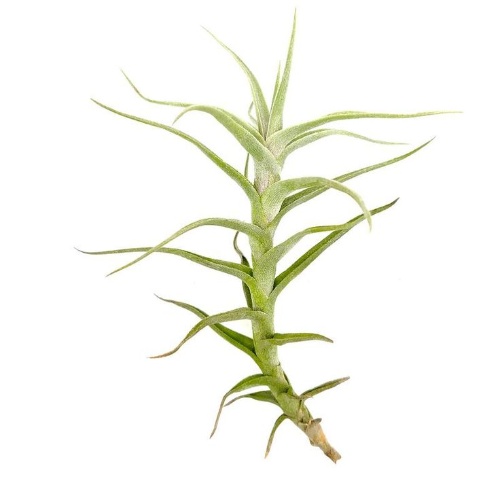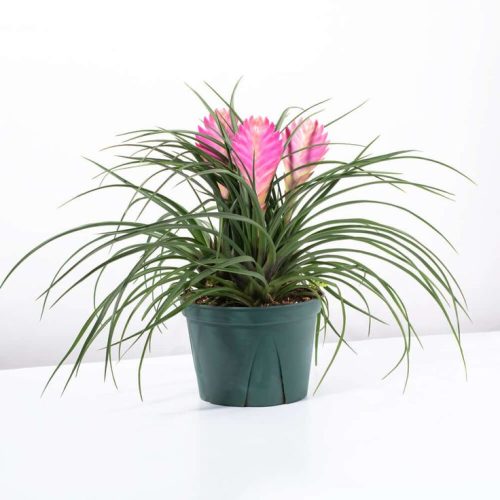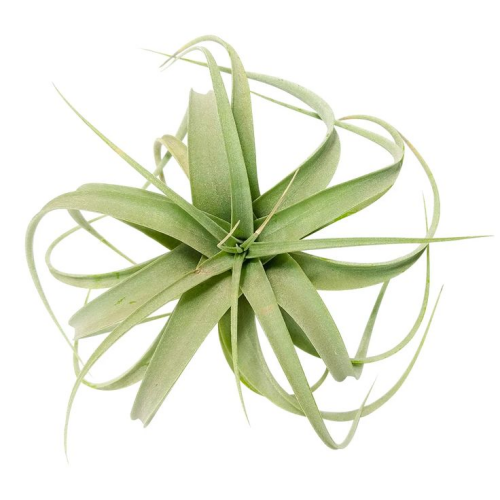Tillandsia Caput Medusae
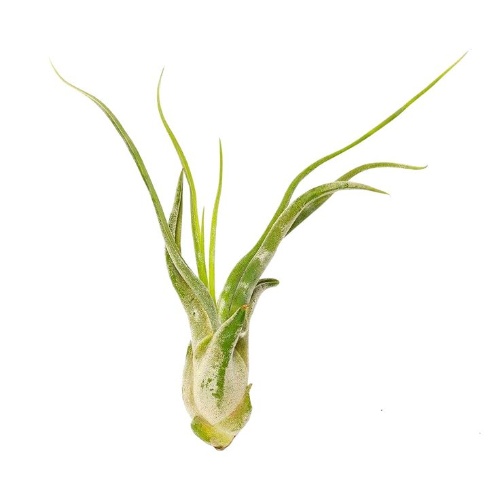
- Botanical Name: Tillandsia caput-medusae
- Family Name: bromeliaceae
- ลำต้น: 8-10 Inch
- อุณหภูมิ: 18°C~30°C
- Others: Light, moist, frost-free, drought-tolerant.
ภาพรวม
คำอธิบายผลิตภัณฑ์
Medusa’s Green Gripe: Taming the Airborne Siren
Tillandsia Caput Medusae: The Medusa’s Head Air Plant Profile
Tillandsia Caput Medusae, also known as the Medusa’s head, originates from Central America and Mexico, including regions such as Mexico, Honduras, Guatemala, and El Salvador. This epiphyte is commonly found in seasonally dry tropical biomes, with an elevation range from sea level up to 2400 meters.
ในแง่ของลักษณะทางสัณฐานวิทยา Tillandsia Caput Medusae is famous for its unique appearance, with long, slender leaves that curl and twist, resembling snakes, which is why it is named after the mythical Medusa from Greek mythology. The leaves are typically gray-blue and arranged in a rosette pattern, reaching up to 25 centimeters in length. The plant’s height generally ranges from 15 to 40 centimeters. Its flowers are tubular and blue-red, usually blooming in early summer.
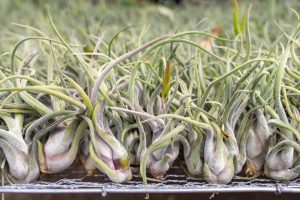
Tillandsia Caput Medusae
นอกเหนือจากลักษณะของใบและช่อดอกแล้วคุณสมบัติอื่น ๆ ของ Medusae Tillandsia Caput Medusae รวมถึงความจริงที่ว่ารากของมันใช้สำหรับการยึดติดกับต้นไม้หรือวัตถุอื่น ๆ โดยไม่จำเป็นต้องใช้ดิน พืชนี้ดูดซับน้ำและสารอาหารจากอากาศผ่านเครื่องชั่ง (trichomes) บนใบของมันแทนที่จะผ่านรากของมัน นอกจากนี้พืชชนิดนี้มีความสัมพันธ์ทางชีวภาพกับมดในป่าโดยมีมดทำรังในฐานที่สูงเกินจริงของลำต้นและพืชที่ให้ที่พักพิงในทางกลับกันรวมถึงการได้รับปุ๋ยธรรมชาติและการควบคุมศัตรูพืชจากมด
The Majestic Domain of the Medusa’s Head: Air Plant Empire
อบอุ่นเหมือนฤดูใบไม้ผลิ
Tillandsia Caput Medusae ชอบสภาพแวดล้อมที่อบอุ่นโดยมีช่วงอุณหภูมิที่เหมาะสมระหว่าง 15-27 องศาเซลเซียส (60-80 องศาฟาเรนไฮต์) รักษาอุณหภูมิไม่ต่ำกว่า 15 องศาเซลเซียสเพื่อหลีกเลี่ยงความผันผวนของอุณหภูมิที่รุนแรงและทำให้แน่ใจว่าพืชจะสะดวกสบายเหมือนวันฤดูใบไม้ผลิ
มวลชนที่ชื้น
โรงงานอากาศแห่งนี้ชอบความชื้นสูงและแนะนำให้หมอกอย่างน้อยสัปดาห์ละครั้งหรือสองครั้งเพื่อเพิ่มความชื้น microclimate ชื้นสามารถจำลองได้โดยวางไว้บนหน้าต่างในห้องน้ำหรือห้องครัวหรือโดยใช้ถาดที่มีน้ำและก้อนกรวดเพื่อรักษาไว้
สดใส แต่อ่อนโยน
Tillandsia Caput Medusae ต้องการแสงที่สว่างและทางอ้อมเพื่อป้องกันการแผดเผาใบจากแสงแดดโดยตรง แสงทางอ้อมประมาณ 12 ชั่วโมงนั้นเหมาะอย่างยิ่งมีแสงสว่างในตอนเช้าหรือแสงยามบ่ายที่อ่อนโยนเป็นตัวเลือกที่ดีที่สุด
การไหลเวียนของอากาศ
การไหลเวียนของอากาศที่ดีเป็นสิ่งสำคัญสำหรับสุขภาพของ Tillandsia Caput Medusae ซึ่งช่วยป้องกันการสะสมของความชื้นส่วนเกินและลดความเสี่ยงของโรคเน่าและโรคเชื้อรา ตรวจสอบให้แน่ใจว่าพืชถูกวางไว้ในพื้นที่ที่มีการระบายอากาศดีหรือให้สายลมอ่อนโยนจากหน้าต่างที่เปิดอยู่หรือพัดลมในระดับต่ำ
ไม่จำเป็นต้องใช้ดิน
ในฐานะที่เป็น epiphyte Tillandsia Caput Medusae ไม่ต้องการดินและสามารถดูดซับน้ำและสารอาหารที่จำเป็นจากอากาศ หากเลือกที่จะปลูกในดินให้ใช้สื่อที่มีการระบายน้ำและสารอาหารที่ดี
หมอกปานกลาง
โรงงานอากาศนี้ดูดซับน้ำผ่านใบและควรได้รับการรดน้ำในระดับปานกลางเพื่อป้องกันการเน่า หมอกสัปดาห์ละครั้งหรือสองครั้งปรับความถี่ตามความชื้นโดยรอบเพื่อให้พืชชื้นอย่างเพียงพอ
การดูดซึมตามธรรมชาติ
แม้ว่า Tillandsia Caput Medusae สามารถเติบโตได้โดยไม่ต้องใช้ปุ๋ย แต่การใช้ปุ๋ยเหลวที่เจือจางหนึ่งครั้งหรือสองครั้งต่อเดือนในช่วงฤดูปลูก (ฤดูใบไม้ผลิและฤดูร้อน) สามารถส่งเสริมการเติบโตที่ดีขึ้น
When caring for Tillandsia Caput Medusae, the most critical aspects are ensuring it receives the right amount of indirect light, maintaining optimal humidity and temperature levels, and providing good air circulation. It’s also essential to water the plant moderately to prevent over-saturation and root rot, as it does not require soil and absorbs nutrients and moisture directly from the air. Additionally, applying fertilizer in moderation during the growing season is important for supporting its growth without causing damage.





